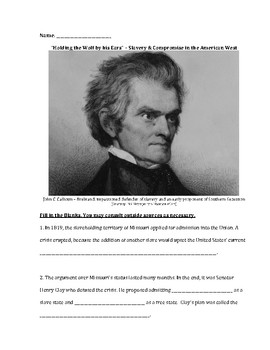"Holding the Wolf by his Ears" – Slavery and Compromise in the American West
- PDF
Description
Not long before his death in 1826, Thomas Jefferson famously described America's relationship with slavery as
"(H)aving a wolf by the ears...we can neither hold him, nor safely let him go." Decades later, his words proved prophetic, as the unresolved moral and legal questions surrounding slavery escalated into a series of factional disputes which threatened to tear the young republic apart.
Featuring important historical figures and terms such as, Henry Clay, John C. Calhoun, the Missouri Compromise, Daniel Webster, Stephan Douglas, Popular Sovereignty and the Compromise of 1850, this twelve-question, fill-in-the-blank worksheet devotes itself to the disagreements that arose over slavery's westward expansion.
Using their textbooks and/or the Internet, students will use the clues provided to discover how America's failure to resolve the issue of slavery would lead to growing calls for Southern secession, and eventually, to civil war.
Perfect as an in-class activity, take-home assignment or review sheet!
MashAvz strives to create academic material that is intelligent, fun and appealing to the eye. We hope that our curriculums will stoke your students' intellectual curiosity and love of the arts, while also instilling in them a great respect for the world's diversity.





